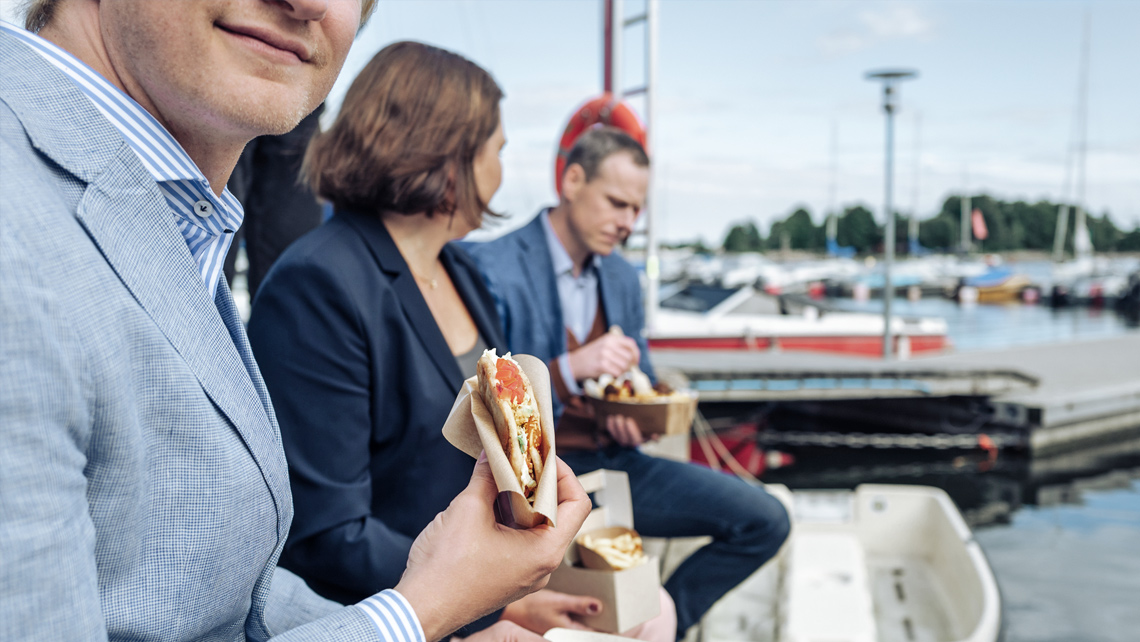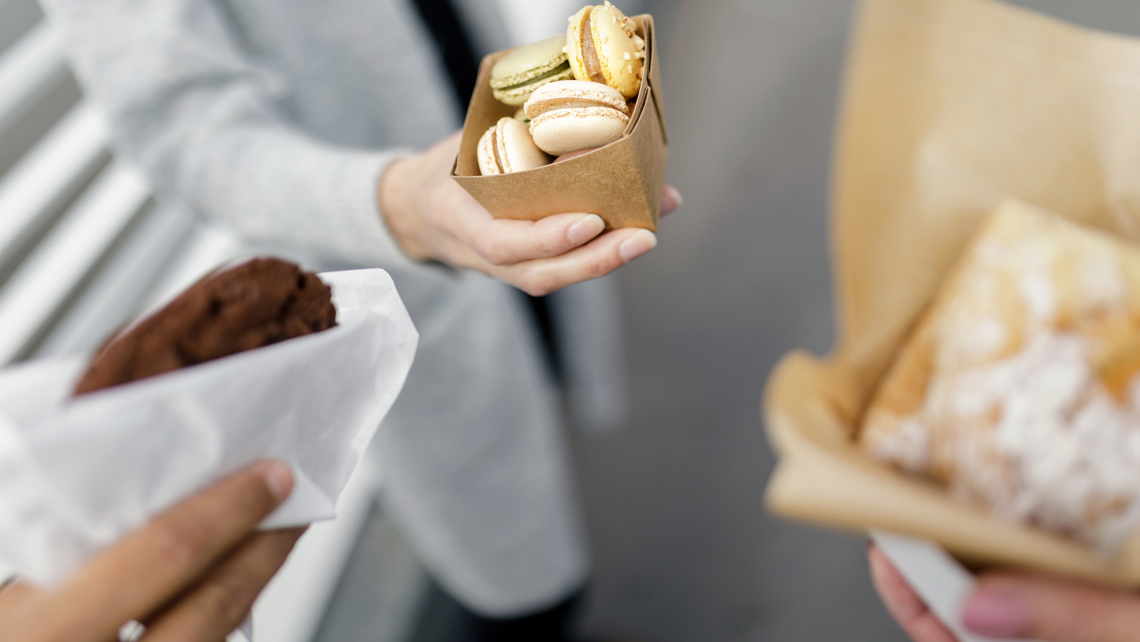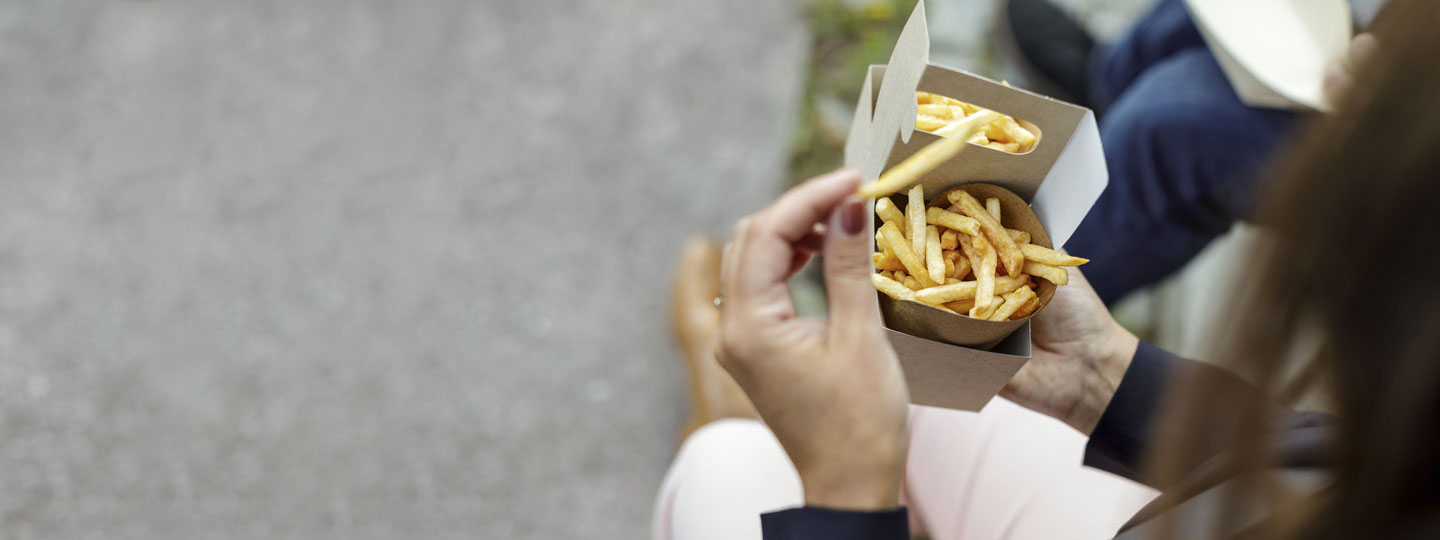FennoGuard GO is an innovative barrier solution that enables the development of fully recyclable and repulpable paper and board packaging. The dispersion barrier coating helps to reduce and replace plastics, e.g. Polyethylene (PE) extrusions, used in fiber-based packaging to create needed resistance against oil and grease, moisture, or other substances.
1. Which end uses is FennoGuard GO best suited for?
FennoGuard GO provides excellent oil and grease barrier properties and tailored water vapor resistance, and it is mainly intended for food service board and flexible packaging paper. Typical use case for paper or board that is treated with FennoGuard GO are take away food and fresh bakery products. In these cases, the packaging needs to provide good protection against grease and an optimized vapor resistance. Another example of a demanding end use is packaging for greasy pet food, which requires superior oil and grease barrier and long shelf life.
2. Is the dispersion barrier coating recyclable and compostable?
The compostability and repulpability of fiber-based material that is treated with FennoGuard GO have been proven in a series of tests. The dispersion barrier coating disintegrates in compost and breaks down in the repulping process, which makes the material easy to recycle. However, the base material has an impact on the end-product’s end of life properties, which means that each end-product needs to be tested for compostability and repulpability individually.
It’s good to know that the requirements to claim that a fiber-based packaging is compostable vary between different regions. All schemes study the characteristics of both the packaging and its components and their ability to biodegrade and disintegrate, and take into account the quality of resulting compost. There are on-going efforts in EU to create more clear and uniform guidelines on making compostability claims, and similar action is taken e.g. by the Chinese industry organizations.
3. What is the key benefit of dispersion barrier technology?
Dispersion barrier coating is a sustainable option for providing oil and grease barrier properties, among others, in food packaging as it helps improve the packaging material recyclability and reduces exposure to plastics. It is also a safe alternative to replace the harmful fluorochemistries (perfluoro and polyfluoro alkyl substances, PFAS) that have already been banned in some countries. For the fiber-based packaging material manufacturers, the technology enables the production of higher value products with fewer production steps, e.g. by removing the need for a separate extrusion coating phase. Additional benefits for the paper and board producers include time, material, and production efficiency.
4. Is FennoGuard GO made from renewable raw materials?
The first generation of FennoGuard GO already has a share of renewable bio-based raw materials to replace fossil-based chemistries, which helps further lower the environmental footprint of the food packaging material. We are committed to developing sustainable chemistry solutions and taking steps forward according to our biobased strategy to further reduce exposure to fossil-based raw materials.
5. Does dispersion barrier coating prevent mineral oil migration?
Yes, FennoGuard GO provides proven functional barrier against mineral oil residual migration (MOSH and MOAH). The transfer of harmful mineral oil hydrocarbons from the food contact material to the food is a safety concern especially when recycled fibers are used in production. The latest regulatory update on the topic comes from Germany: a draft for the country’s new Mineral Oil Ordinance by the Federal Ministry for Food and Agriculture (BMEL) proposes that the use of a functional barrier is mandatory in all food contact materials that are manufactured using recycled fibers.
6. Is FennoGuard GO approved for use in food contact?
FennoGuard GO is compliant with key food contact regulations: EU Framework Regulation and the German BfR requirements, which provide the basis for compliance in Europe, FDA §176.170 for North American market, and the Chinese GB9685 standard.
7. What about the runnability of the barrier coating product?
FennoGuard GO has proven runnability on paper and board machines and on converting lines. Convertibility is one of the key features in barrier coating for food packaging. Soft polymers offer flexible coating that gives the needed creasing and folding properties for the packaging, but typically the softer the polymer, the higher the blocking tendency. Our innovative technology overcomes the challenge and FennoGuard GO provides flexible barrier layer while also maintaining low blocking tendency.
8. FennoGuard GO is based on open formula. How is the performance of the tailored barrier coating ensured?
The open formula allows us to help our customers to optimize the barrier performance for the specific packaging end use and tailor the product to meet the needs of their individual paper machines or coating lines. Kemira has excellent capabilities for simulating all the steps from coating color formulation to coating and converting in the laboratory before moving to pilot and mill trials. Barrier performance can also be tested in Kemira laboratory.
9. Is there a preferred application method for dispersion barrier coating?
There is a broad variety of different coating methods in the industry and as each method has its pros and cons, there isn’t just one recommended method for applying dispersion barriers. There are many variables to consider when choosing the coating method, but the best performance can only be reached when a uniform, pinhole-free film is formed on the substrate. Close attention should also be paid to the coating structure, e.g. to the ability to apply thin coating layers. Functional surface barrier can also be applied at the converter utilizing printing units, such as flexography.
10. How to achieve optimized barrier performance in fiber-based packaging?
In addition to the properties of the dispersion barrier itself, both the application method and the base material properties have a strong impact on the final barrier performance. Right porosity and smoothness of the base paper lay the foundation for creating a uniform barrier coating layer. So, the barrier performance optimization starts already with the fiber and furnish component choices, contributing e.g. to the packaging material strength and flexibility. Sizing and the sheet’s hydrophobicity characteristics also play a crucial role in e.g. the adhesion of the coating. End-to-end expertise in papermaking and application knowhow ensure a fully optimized barrier coating for food packaging.


